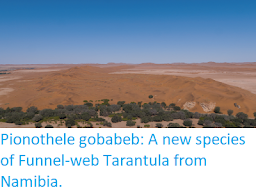Belippo is a small, Afrotropical genus of Ant-mimicking Jumping Spiders, Salticidae, currently containing 12 species. It is a well-defined genus, which was last revised by Fred Wanless of the Museum of Natural History in 1978. At this time Wanless listed seven species of Belippo. Since 2013 a further five species have been described by Charles Haddad of the Department of Zoology and Entomology at the Univeristy of the Free State, Wanda Wesołowska of the Department of Biodiversity and Evolutionary Taxonomy at the University of Wrocław, and Konrad Wiśniewski of the Institute of Biology and Earth Sciences at the Pomeranian University in Słupsk. Almost all Belippo species are rarely collected, probably due to their small sizes and preferrence for concealed or hardly accessible habitats; and also due to an overall undersampling of the African Salticid fauna. Biology of the majority of Belippo species remains unknown. The available data suggest that members of this genus can occur in leaf litter or on shrubs in the forest understorey and are usually found in association with Ants.
In a paper published in the journal Arthropoda Selecta on 30 March 2020, Wanda Wesołowska and Konrad Wiśniewski describe a new species of Belippo from Côte d'Ivoire.
The new species is named Belippo eburnensis, which is derived from the Latin name of the country of origin (Litus Eburneum). The species is described from five male and two female specimeWesołowskans collected from the vicinity of Man, Mont Toukoui, about 1200 m above sealevel, in July 2017 by Yves Braet and Arsène Gué, and housed in the collection of the Royal Museum for Centra Africa in Tervuren.
Males of Belippo eburnensis are small Ant-like Spider, with slender bodies. The cephalic and thoracic part of carapace is separated by fissure. Cephalic part higher and broader than thoracic part. Carapace black, slightly pitted, light brown streak in constriction, some white hairs at the anterior eye row, a few long dark bristles on sides of eye field and at fovea. Mouth parts and sternum brown. Chelicera dark brown, with distal prolateral spur and second minute spur on lateral keel, groove with three promarginal and six retromarginal teeth. Abdomen black, covered with short black hairs, dorsum covered with two shining scuta, constriction at one-third of abdominal length. Oblique whitish marks on lateral surface of abdomen, venter grey with large dark brown rectangular area. Spinnerets generally dark, posterior lighter. Coxae I and II yellowish, III brown, IV yellowish with dark sides. Leg I blackish, only apical end of tibia and tarsus light (in some specimens leg I lighter, yellowish with black femur only). Leg II whitish yellow, dark streaks along lateral sides of femur. Leg III: dark femur and slightly dimmed metatarsus, remaining segments light. Leg IV: blackish femur, darkened on dorsum of patella apically, two third of tibia dark, metatarsus light with dark streaks along sides. Patella I with two spines, tibia I with five pairs of long ventral spines, metatarsus with two pairs; spination of leg II similar, but on tibia only 3 pairs of ventral spines. Pedipalp blackish, tibial apophysis harpoon-shaped with three additional denticles at its base, tegulum rounded, embolus encircles bulb twice, with pars pendula.Embolic tip pincer-shaped, its two tips jointed by a membrane, viewed slightly from below it looks like a halberd. Two stout bristles on the cymbium tip.
Females of Belippo eburnensis are similar to the males. Abdomen pyriform, wider behind constriction, covered with thin hairs. Colouration generally black, brighter at carapace furrow, lateral light marks in abdominal constriction, venter of abdomen grey. Chelicera with four teeth on promargin (one of them placed separately) and six on retromargin. Coxae light, except coxae III that are brown. Legs slender, generally blackish with dirty yellow patellae and distal segments, femora II yellowish with dark stripes along sides, similar streaks on tibia IV. Pedipalps oblate, black. Epigyne weakly sclerotized, with a large central depression, pockets placed at sides of the depression, the conformation is slightly changeable. Seminal ducts membranous, thin, long, meandering; spermathecae composed of two spherical chambers connected with long ducts, second chamber surrounded by amorphous glandular tissue.
Three western African species of Belippo, namely Belippo cygniformis, Belippo ibadan and Belippo eburnensis, are closely related. Belippo ibadan has a slimmer body than in two related species. The female copulatory organs of Belippo eburnensis and Belippo ibadan are very similar and hardly distinguishable, whereas the female of Belippo cygniformis is yet unknown. Some epigynal features that can be used in distinguishing the species, such as the conformation of the extremely long and delicate seminal ducts, could be misleading, as they strongly vary depending on how the epigyne was
desiccated. The other problem concerns specimen colouration, which sometimes varies within some Myrmarachnini species. The male palpal organs in these species are rather similar and differ only in the shape of the embolic tip. It is pointed in Belippo ibadan, slightly broadened with a shallow notch in Belippo cygniformis, and clearly pincer-like in Belippo eburnensis Based on morphological characters, the two latter species are most similar to each other. In our opinion, it is very likely that these three species represent a single. phylogenetic lineage and can be united in the newly proposed cygniformis species group. Although the available data on the preferred microhabitats by Belippo species are very limited, the three related species seem to prefer slightly different microhabitats. Belippo eburnensis was collected by Malaise trap and is likely to occur on shrubs in the forest understorey, Belippo ibadan is known to occur in leaf litter, whereas Belippo cygniformis was reported as occurring in tree canopies.
See also...









